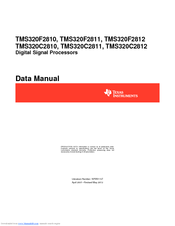Texas Instruments TMS320C2812 Controller Manuals
Manuals and User Guides for Texas Instruments TMS320C2812 Controller. We have 1 Texas Instruments TMS320C2812 Controller manual available for free PDF download: Data Manual
Texas Instruments TMS320C2812 Data Manual (172 pages)
Digital Signal Processors
Brand: Texas Instruments
|
Category: Signal Processors
|
Size: 1.76 MB
Table of Contents
Advertisement
Advertisement
Related Products
- Texas Instruments TMS320C2802 Data
- Texas Instruments TMS320C2801 Data
- Texas Instruments TMS320C2810
- Texas Instruments TMS320C2811
- Texas Instruments TMS320C6722
- Texas Instruments TMS320C6713
- Texas Instruments TMS320C6201
- Texas Instruments TMS320C6670
- Texas Instruments TMS320C54x
- Texas Instruments TMS320C5x
